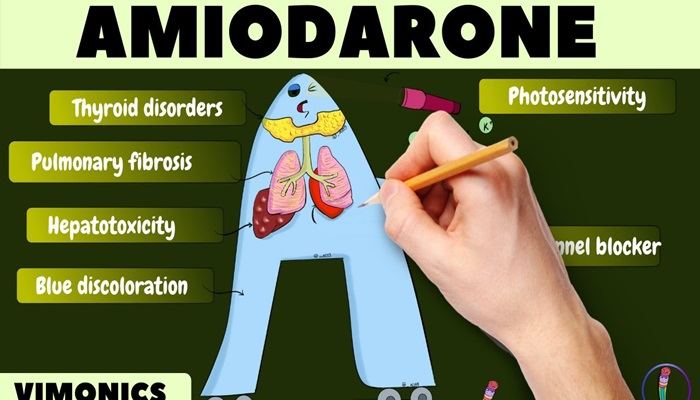Amiodarone is a potent antiarrhythmic medication widely used in the management of various cardiac arrhythmias, particularly in cases of life-threatening ventricular tachycardia and fibrillation. While it has proven efficacy in stabilizing heart rhythms, amiodarone is associated with a range of side effects, one of the most significant being hypotension, or low blood pressure. This article delves into the relationship between amiodarone and hypotension, exploring its mechanisms, incidence, clinical implications, and management strategies.
Understanding Amiodarone
Amiodarone acts primarily by prolonging the refractory period in cardiac tissues, which helps to restore normal heart rhythm. It affects multiple ion channels, including sodium, potassium, and calcium channels, leading to its antiarrhythmic properties. Despite its benefits, amiodarone has a complex pharmacokinetic profile and a narrow therapeutic index, which increases the risk of adverse effects.
Mechanism of Action
The drug’s mechanism involves blocking adrenergic receptors and inhibiting the reuptake of norepinephrine. This multifaceted action results in both antiarrhythmic effects and potential hemodynamic changes. The vasodilatory properties of amiodarone can lead to decreased systemic vascular resistance, contributing to hypotension.
Incidence of Hypotension with Amiodarone
Hypotension is a well-documented side effect of amiodarone administration. The incidence varies depending on the route of administration:
Intravenous Administration: Hypotension occurs in approximately 15% to 70% of patients receiving intravenous amiodarone. The risk is particularly pronounced during the initial loading doses when higher concentrations are introduced into circulation.
Oral Administration: While oral forms of amiodarone can also cause hypotension, the effects are generally less severe compared to intravenous administration.
Risk Factors
Certain patient populations may be at higher risk for developing hypotension when treated with amiodarone:
Older Adults: Due to age-related changes in pharmacodynamics and pharmacokinetics.
Patients with Pre-existing Cardiovascular Conditions: Such as heart failure or significant coronary artery disease.
Concurrent Use of Other Medications: Especially those that also lower blood pressure or have cardiodepressant effects (e.g., beta-blockers, calcium channel blockers).
Mechanisms Behind Amiodarone-Induced Hypotension
The mechanisms by which amiodarone induces hypotension are multifactorial:
Vasodilation: Amiodarone causes direct vasodilation by relaxing vascular smooth muscle, which reduces systemic vascular resistance and leads to lower blood pressure.
Myocardial Depression: High doses can depress myocardial contractility, further contributing to decreased cardiac output and hypotension.
Cosolvents in Formulation: The presence of certain cosolvents like polysorbate 80 in intravenous formulations may exacerbate hypotensive effects by affecting cardiac function.
Anaphylactic Reactions: In rare cases, hypersensitivity reactions can occur, leading to acute hypotension.
Clinical Implications
The occurrence of hypotension during amiodarone therapy poses significant clinical challenges:
Monitoring: Continuous blood pressure monitoring is essential during intravenous administration to detect hypotension early and manage it effectively.
Patient Symptoms: Patients may experience dizziness, lightheadedness, or syncope due to low blood pressure. These symptoms necessitate immediate intervention.
Potential for Severe Outcomes: Severe hypotension can lead to inadequate perfusion of vital organs and may precipitate cardiogenic shock if not addressed promptly.
Management Strategies for Amiodarone-Induced Hypotension
Management of hypotension associated with amiodarone involves several strategies:
Initial Response
Reduce Infusion Rate: For patients receiving intravenous amiodarone, slowing down the infusion rate can help mitigate hypotensive effects.
Fluid Resuscitation: Administering intravenous fluids may help restore blood volume and improve blood pressure.
Vasopressors: In cases where fluid resuscitation is insufficient, vasopressor agents may be necessary to stabilize blood pressure.
Long-term Considerations
Adjusting Doses: Careful titration of amiodarone doses based on patient response and tolerance is crucial.
Alternative Formulations: Exploring newer formulations that minimize adverse effects could be beneficial for patients who experience significant hypotension with standard preparations.
Education: Educating patients about the signs and symptoms of hypotension can empower them to seek timely medical attention if needed.
Conclusion
Amiodarone remains an essential tool in managing life-threatening arrhythmias; however, its potential to cause hypotension must be carefully managed. Understanding the mechanisms behind this side effect and implementing appropriate monitoring and management strategies can help mitigate risks associated with its use. As research continues into safer formulations and alternative therapies for arrhythmias, clinicians must remain vigilant regarding the hemodynamic effects of amiodarone therapy to ensure optimal patient outcomes.
In summary, while amiodarone is effective in treating severe arrhythmias, clinicians must balance its benefits against the risk of hypotension through careful patient selection, monitoring, and management strategies tailored to individual needs.
Related topics:


